Quite a while ago now we took a stab at creating a back-of-product label that would outline the environmental impact the product you were holding has; whether it’s a piece of food, a processed product, a fashion item, homewares or anything else.
We do it with nutritional label on food. We do it with energy efficiency on appliances (but then bizarrely don’t take into the account the rest of the environment destruction of these). We label cigarettes specifically in some countries to discourage use. Why not do it with the environment?
Click here to use the prototype.
We created some very basic project boundaries that were extremely broad
- The label must try to account for all general-use items where possible (food, furniture, clothes, hardware, toys etc)
- For now, pretend we’re in an ideal world
- It has to fit on most product packaging
- It has to work across the world (with translation for text)
It wasn’t a scope. We didn’t run a design sprint or go out and do a huge customer piece. We studied some industry data and had plenty of anecdotal evidence of a few personas and assumptions. We did it differently then you would normally structure these projects. We designed the thing quickly and loosely to try and show an idea but leave it open enough to garner many ideas in turn, and then threw it out there for feedback. And we got a lot of it (thank you!).
We received countless pieces of positive feedback that people would like to see this on their products, and also lots of constructive criticism and thoughts.
- With this label you will need some kind of legend or key for those that are unfamiliar with measures such as ha (hectares).
- Where it talks about the CO2 emissions, trees destroyed, etc. I have no idea what the abbreviations next to the numbers mean.
- My idea it wasn’t so about text, but for start with colors. Because many people don’t understand what all this mean and the real impact.
- What if instead of counting calories, people could use these labels to count their footprint?
- I think one of the biggest problems is that while people understand the big issue they are disconnected from the impact their individual everyday choices make. An initiative like this would shift responsibility to the individual and empower them to make better choices.
- You realize companies would never do it? That directly creates a bad image for them. On the other hand, I think we should take this action in our hands, print those labels out, and just go around the stores sticking it to the products 🤷🏻♂️
- A very interesting idea! I think it would need some clarity though as without a ‘good’ or ‘best practice’ to compare to people might find it confusing. Also would be very interested to know how you calculate some of the figures, in particular animal impact. You might get more buy in from companies too if you flag the positives, so good companies get a label & bad companies are shamed as they don’t want to disclose!
- Is palm oil free inclusive of all palm oil or just unsustainably harvester palm oil? And the animals affected, is that individual numbers, species, or something else altogether?
- Maybe that’s just me but for emissions I would add a comparison to a car or something people can understand and relate to better.
- My only suggestion would maybe change a bit of the wording- for example “trees destroyed” has a negative connotation, and while I agree that we shouldn’t be using trees if possible, I believe it would be a lot easier to get companies to agree to this if the connotations aren’t as negative.
- You should perhaps add a section about where the product was produced as well, since ethical labor is also such an issue. I see the ethical labor thing, I just mean it should be a little more specific since its so easy to just claim ethical labor and hide the truth, kind of like how “artisan” gets slapped on stuff because theres no real definition.
- I wonder if the average consumer would understand the emissions number? Perhaps rather a red, orange or green indicator?
- Most consumers don’t have the time to read all the info prior to purchasing so this probably won’t be as affective as we want it to be (it being back of pack too). My recommendation would be to put a traffic light indicator on front of the label which is easier to see for the consumer and also informs them of the environmental impact in less than 5 seconds. Also if this traffics light system is used more manufactures would be proactive to make their products environmentally friendly, no company would want a big red traffic light on the front of their products.
- I’m just putting myself in the shoes of most consumer that are running around the store with kids or stressful jobs. The easier we can make these labels visible to everyone the more effective they will be to inform everyone and allow them to make the best decisions.
- Yes it’s cool that products can claim they are cruelty free and such but imagine the impact if it was the other way round, when products must carry the Not Cruelty Free label 👌🏻👌🏻
The feedback was endless and brilliant from our ideal target (a cross section across the world of varying levels of interest in environmental impact). We categorized it and then drew project guidelines and boundaries from there (essentially reverse engineering what’s normally done).
Questions that needed answering
From here we outlined our HMWs (how might we’s) to further hone into the specifics we needed to address. They included:
- How might we show a quick, good or bad rating for the product overall for busy shoppers?
- How might we explain the measurements?
- How might we determine whether something is green (good) or red (bad)?
- How might we show people the impact from their consumption on any given day or week?
- How might we tie the segmented pieces of work from other enterprises tracking or reviewing certain elements of these (that are often deeper) such as the Good on You app for a number of high-profile fashion brands?
- How might we standardize the data so no other environment labels are needed nor should exist on the product?
Complex problems and thoughts to consider:
- How do we account for the impact of monocultures particularly when plant based ingredients deal with this a lot?
- Biodegradable is a problematic word that can mean different things in different contexts – should we add guidelines for this? Are we fighting an entrenched position?
- Vegan is complicated because most things impact animals (including land clearing), vegan may not always be the environmentally or ultimately ethically sound choice, and vegan doesn’t mean cruelty free either. Where do we decide to sit in this tension?
What do we want this system to do?
- The labelling mandates transparency. It doesn’t work any other way.
- Create laws and regulations that actually help us change our design & manufacturing processes, resource usage and end of life.
- Brand improvement through customer pressure
What we created
- We need a front of product indicator of key metrics that are important to large population and/or key environment indicators
- We need the ability to see more information for everything else to:
a) provide this to the consumers who look for specific things or want to drill down into the data and understand the numbers
b) create a standard structure that can be mandated in law that every product needs to calculate before legally selling in the market
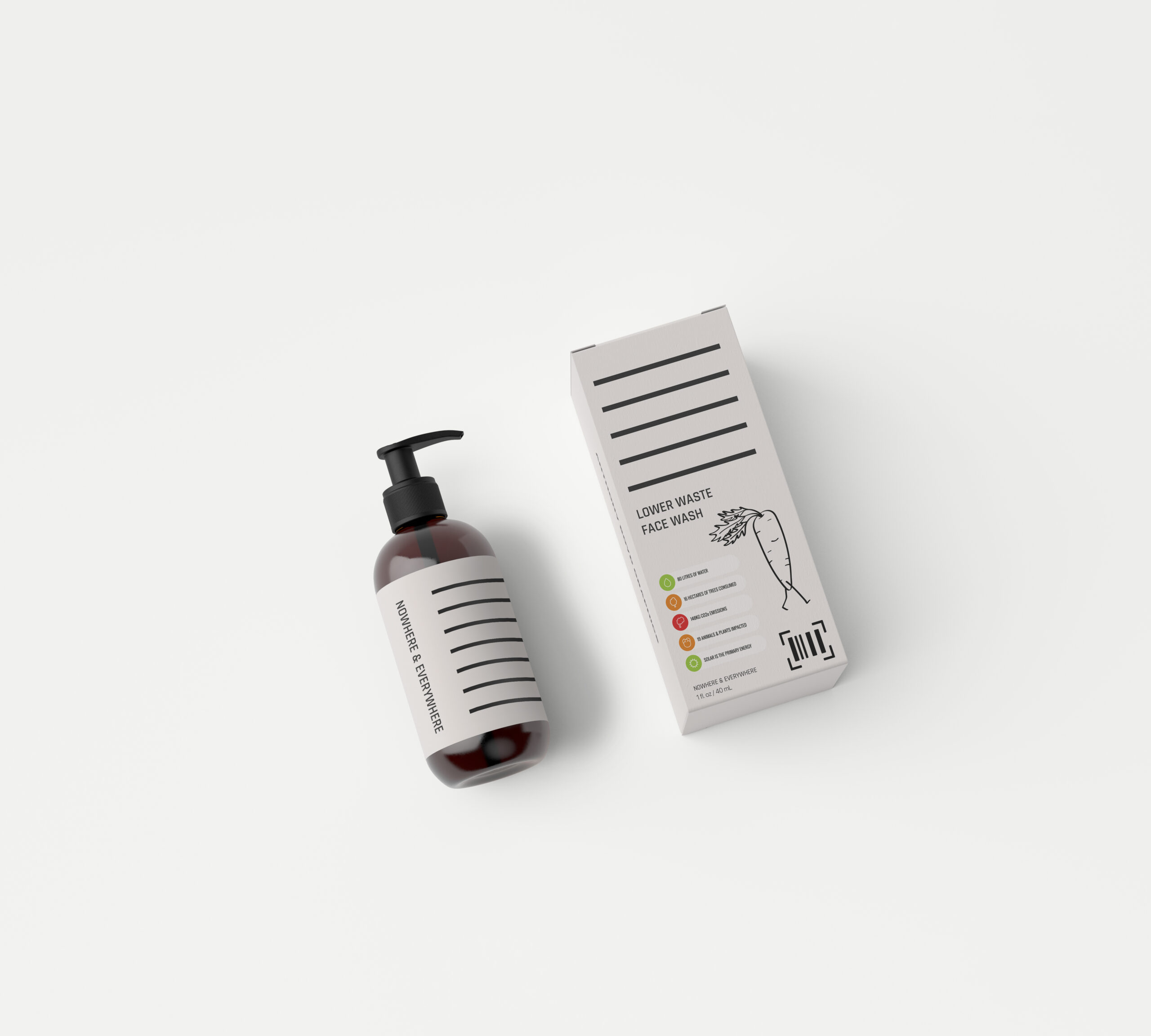

Onto the app
The product would have a scanning code that would automatically open up the app with a home screen of the product information that would look something like this with the color rating systems quickly showing the overall impact of the product.
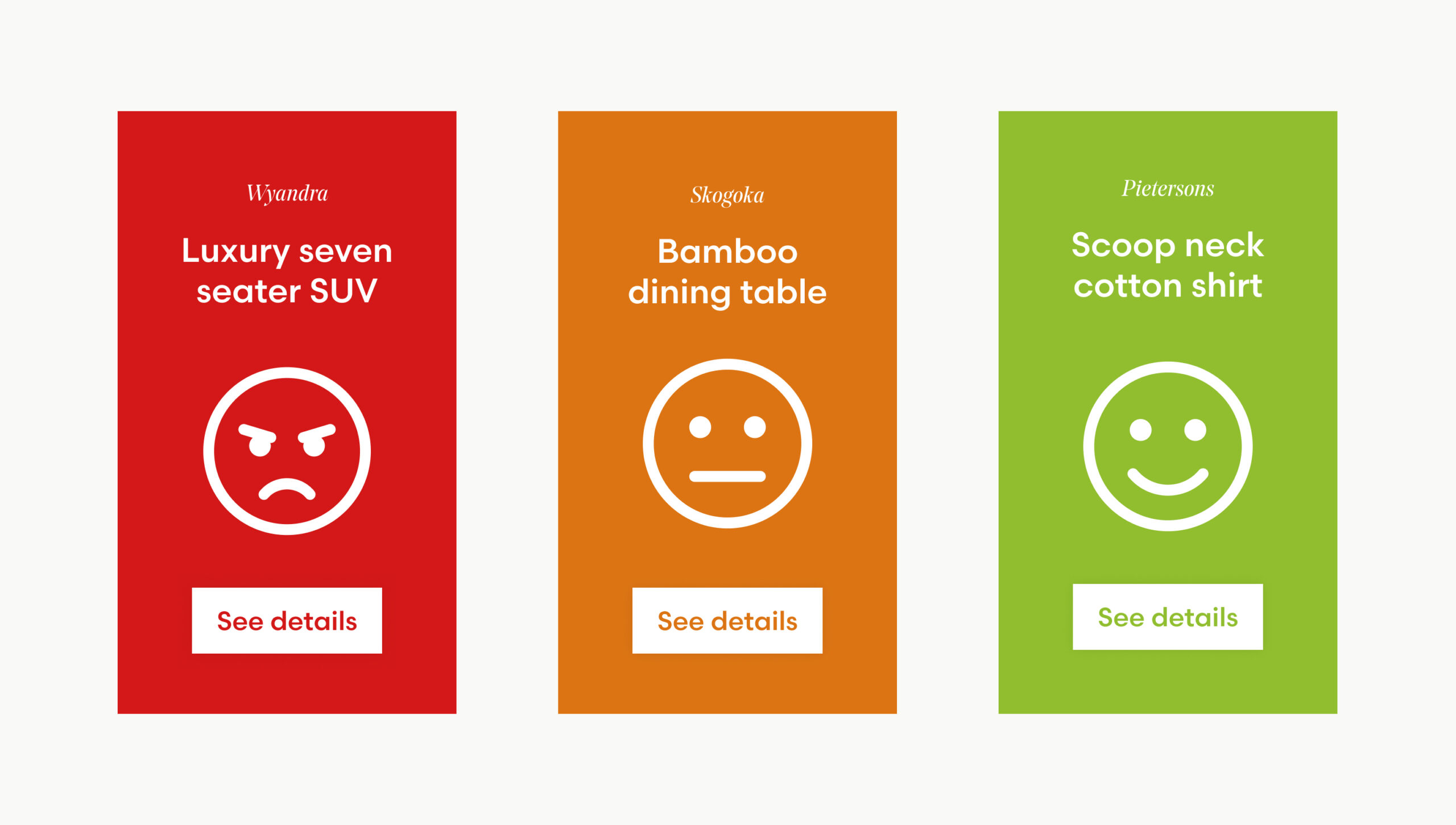
Thoughts on the app
- Some participants and commenters are greatly in favor of having a scan + app combination, others are entirely reluctant. This is interesting. We use technology constantly in our lives now; it’s hard not to see people on their phones even in the shops. We could do more research on the disaggregation of data here. Is it specific age groups this feedback comes from? Locations? How they spend daily life? What could make this a better transition?
- It doesn’t seem unreasonable to scan a code but is there a way to reduce the friction on this?
- Recycling is currently an utterly mismanaged process throughout the world and non standardized labelling is part of this problem. There are little symbols and numbers everywhere, packaging rarely ever guides on how to recycle correctly, and recycling itself is not the be all and end all. Can we compost it at home? Or industrially? Where are the local facilities? Do we need to clean it or strip it of something first? How long will it take to biodegrade? What happens to it in the recycling process? We wanted to solve this by creating an End of Life screen and not requiring anything else on the packaging. This doesn’t address all the issues in this system though; recycling is messy.
- The app needed to include a whole lot more information. This serves many of us who do want to know more but it also ensures we have one standard system that each product must adhere to and we therefore have radically more transparent information. Through this we can legislate out products effectively and force change in others (through policy or consumer pressure).
Prototyping
We designed up a prototype for the app to test how users interacted with it and what they thought.
Note: this was not a user interface (UI) design phase. This is user experience (UX) only and high-fidelity branding and interface design would be part of the next phase.
Option: Another design idea we played with that might still have some legs too for a one-glance indication: one simple colored band on each product.
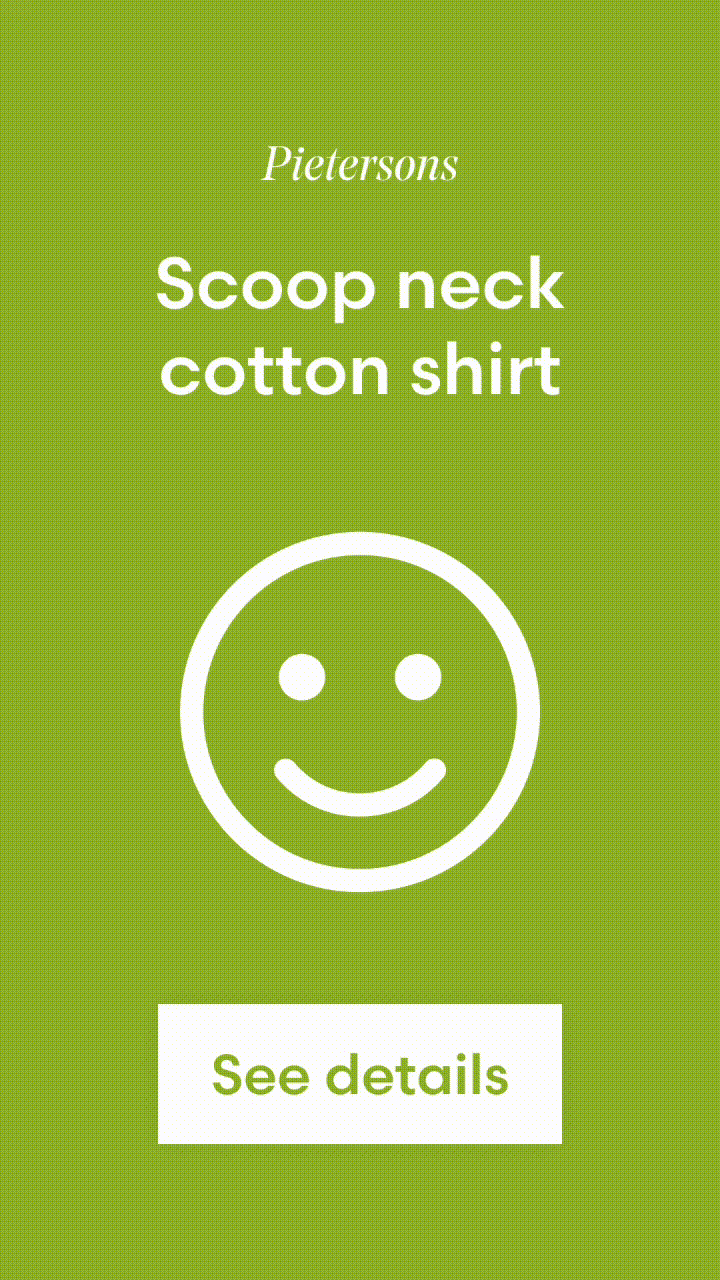
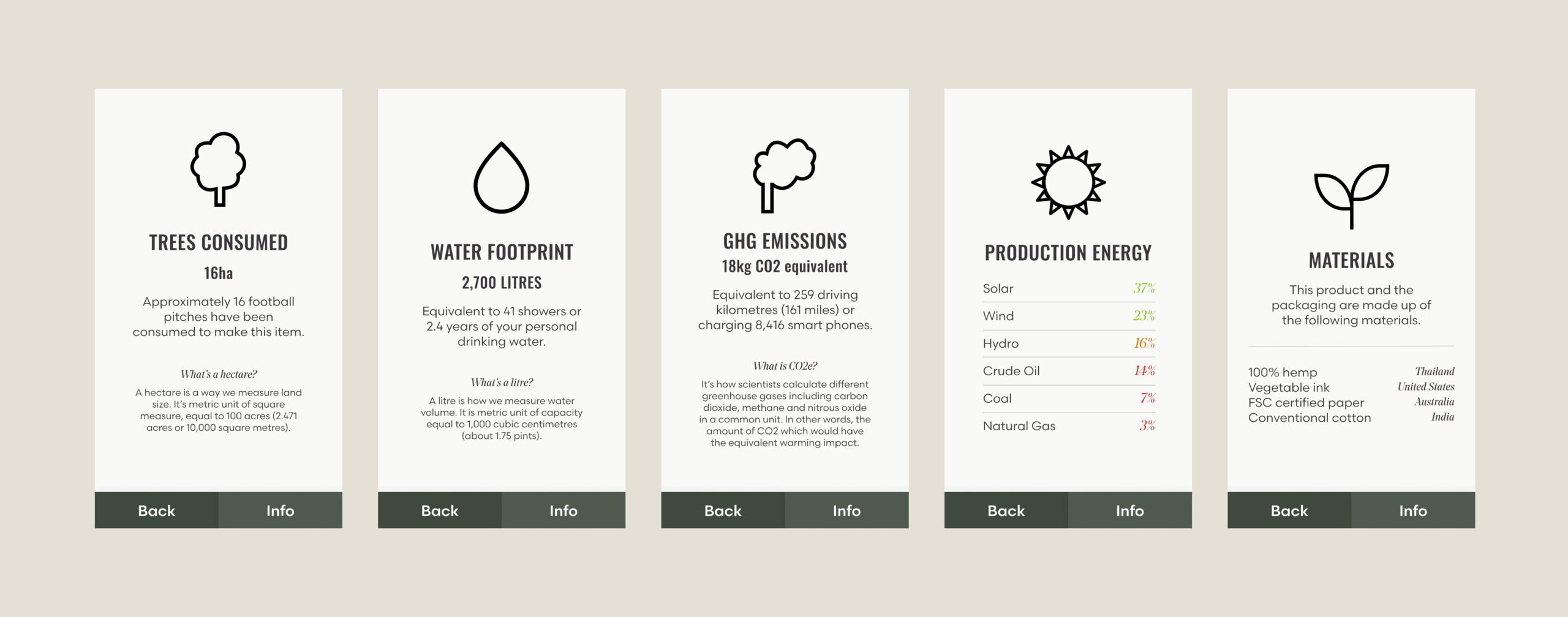
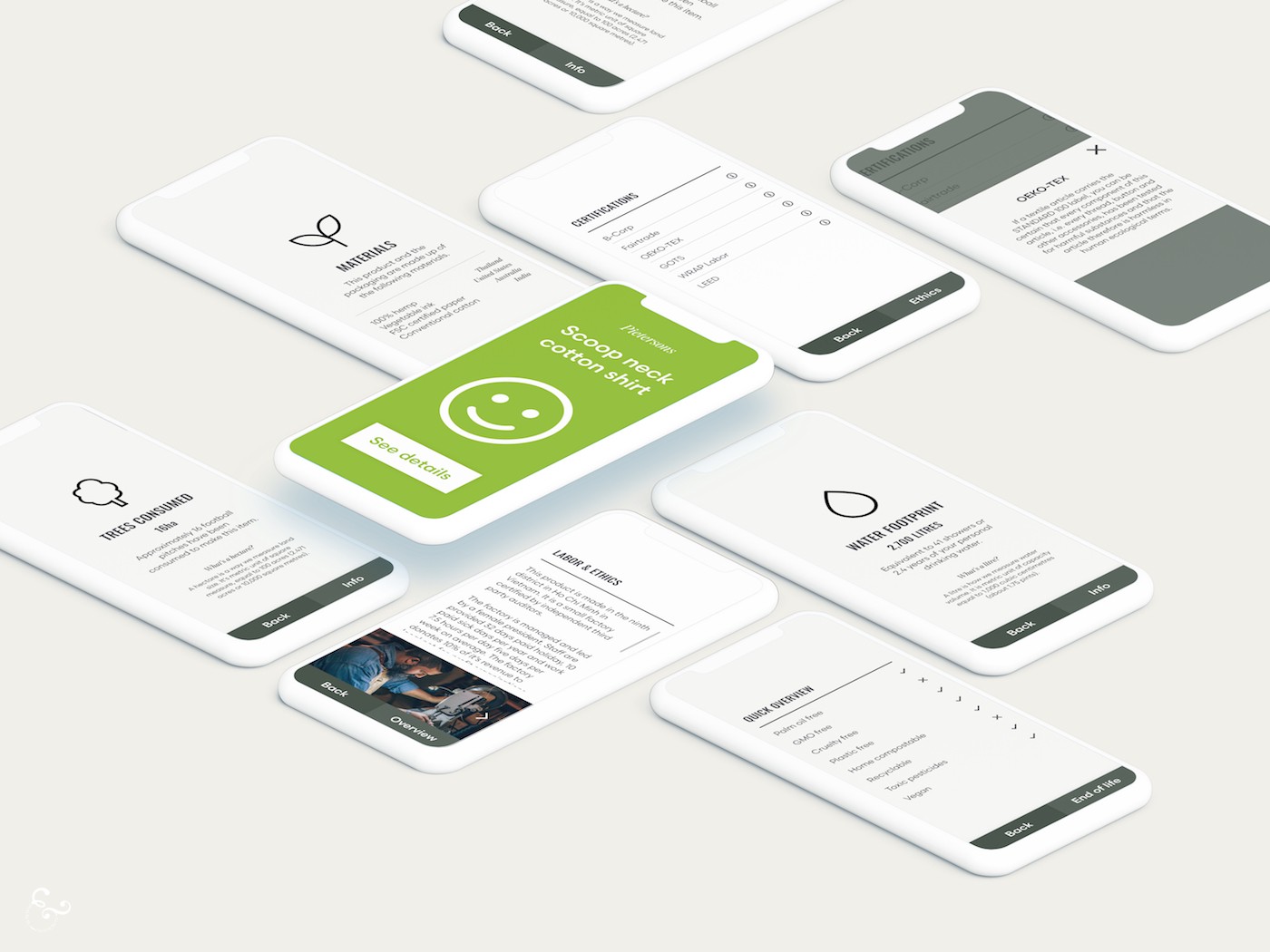
How it works
The app works with the labelling system on the product and the barcode to scan in for more information. On the backend, data is inputted into a global data system. A product cannot legally enter the market without this data entered. It would be our idea that the data is transparent and understood by each vendor in the supply chain so they can provide this on. For example, a fashion manufacturer would be able to gather this data from each of their material suppliers and then calculate the culmination for their garments. This would create a system where we’re constantly pushing back on where we source from in order for that to remain transparent, and move our buying power away when this isn’t adhered to.
One of the biggest downfalls would be the auditing of this. There would need to be a consequence that disincentives bad behavior and plenty of regulations that control how this data is measured and collected.
Notes to make this work
- The labelling must be mandatory (in law and enforced) for this to work. Voluntary labelling is confusing and often meaningless.
- Penalties for selling a product without being on the system.
- We should remove the bulk (if not all) other environment and ethics labels to make this uncluttered and standardized with the rest of the information in the app.
- Ideally, products that don’t meet a certain threshold shouldn’t be allowed on the market altogether.
- These numbers could be made up or manipulated. We need to think of a system whereby we’re uploading evidence and/or getting third party audits by independent, reputable bodies.
- This will absolutely add a burden onto many businesses but it’s one we should account for. Currently that burden has been shifted from businesses onto the environment, animals and exploited people. The burden should be on those of us making the products and offering the services. Governments need to help us with this by legislating effective regulations, closing loopholes, and providing relief for doing so for SMEs (small and medium enterprises) with a specific turnover. Once it’s in place, it’s easier to manage. In a sense we’re also working on an economies of scale here because many products interact with a large number of vendors. If those vendors have completed their calculations of the supply chain they can then provide this to all of their clients who break down the information for the product. Some companies have already started doing this like, surprisingly, Gucci.
- Designers should be able to make their own variations of the icons to fit their packaging design and brand as long as certain guidelines are met (i.e. that it’s consumer facing on the shelf or when handling the item) and it’s within a certain layout and style template.
- All inputs of the data must be entered for a product to hit the market legally. Some of the data points may not be relevant to the product in which case they have a not applicable which then clicks to an information tab on why this is the case.
- There would need to be a website where calculations and assumptions are listed on how measurements are made (some of the app pages reference this).
- Who would own this? Management? Auditing? Funding? Could this be a global consortium? UNEP? How do we create an independent body that is guaranteed to remain bias and corruption free?
- Needs an education marketing roll out for the public.
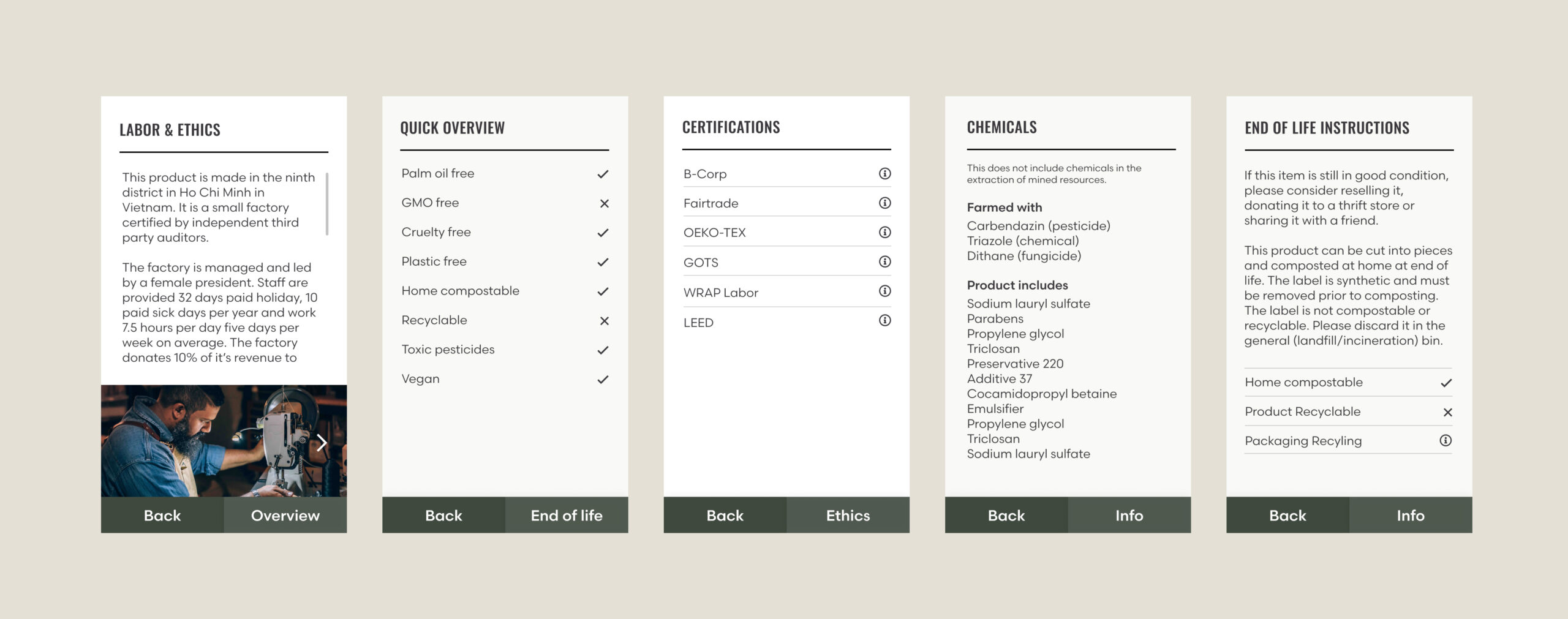
Specific changes we made
- We removed sensitive and threatened land labelling – this should simply be illegal and enforced (recent Australian data shows the enforcement piece of this is abysmal but that falls outside of this scope of work and would change per country)
- We agreed on the points about language and changed trees destroyed to consumed (particularly as this isn’t always terrible!). Thought: should we be distinguishing between old forest and plantations?
- We took out Vegan in the overview. Then put it back in. Then cycled through that a few times. Ultimately we decided it’s a label people specifically look for and re-education on this probably should not be in our remit; at least initially. This framework would be designed to always evolve over time so this could be updated in the future or phase out (for nothing or a better replacement).
- Lis originally designed it to only have green (good) and red (bad) indicators. Something is one or the other. But then another experience designer (Brad – thank you!) suggested that orange does have its place and we agree. There are brands that are trying that we can see progress on. As we’re accounting for numerous indicators it may also be that there is a real swing between what’s good and what’s bad.
- We needed to elaborate more on ethical labor. With so much more ability to do things we also wanted to create an area where brands could show the certifications and audits they’ve received (from vetted options).
Next steps
Implementing Changes & Testing
We’re releasing this for use and testing and would love your feedback! The only way this gets better is with your input. Please use the prototype and leave a comment on our Instagram post or email us – we’d absolutely love to hear from you.
We also need to determine the biodiversity impact. Do we need it? How can we shape this to be a lot more useful? We are struggling on iteration over iteration on this. Let’s decide if it’s needed or if we should pull more experts in to chat this through.
UI Design
Once those changes have been made we can start designing the next level of the user interface for the following release.
Systems Change
There’s a big systems change component to this, we’d like to lay out an initial strategy.
Policy Design
Our disciplines of design thinking, systems thinking, environmental science and policy design are overlapping more and more. This isn’t the focus of this project for the moment but if there is enough public support and project funding magically appeared we would be open to moving it forward to this stage.
Future Step: Your shopping & weekly footprint
Say you’ve gone to the supermarket. You’ve filled up your basket with some fresh produce (pears are in season – yum!), a few pantry staples (flour, soy sauce and rice today), a few bathroom goods (a new soap and some toothpaste for the kids) and a new notebook and pen. What’s your environmental impact?
We’d like to see if we could somehow create ‘receipt’ based environment impacts. Perhaps as we move to nearly entirely electronic payments this could be tied to a transaction number that collects all the inputs. Given all the information is entered in one global database for the app, there should be a method we can pull from this in correlation with purchases. Ideally this would hook into the app if you could create your own account.
You should then also be able to see your weekly, monthly and yearly impact across the metrics too. This essentially shows your footprint and allows you to improve and choose better options where possible. There’s some room here for gamification if that was explored here too but that’s a whole future idea.
Partnership & you
Have a play with the prototype below! The screens will show the same calculations for each type of the goods. We’d love to hear your feedback.
If you’re an organization thinking it would be pretty cool to partner with us on this, please reach out!

